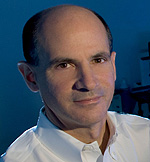Artificial muscle fibers help keep muscle stem cells potent in lab
 There’s no place like home — particularly if you’re a muscle stem cell.
There’s no place like home — particularly if you’re a muscle stem cell.
Snuggled comfortably along the length of our muscle fibers, these stem cells rest quietly, biding their time until the muscle needs to be repaired after injury. Although it’s possible to maintain muscle stem cells in a laboratory dish, they’re not really happy there. Within a short time they begin to divide and lose their ability to function as stem cells.
Now researchers at the Stanford University School of Medicine have come up with a way to create a home away from home for the stem cells in the form of artificial muscle fibers. They’ve also identified the particular “soup” of molecules and nutrients necessary to keep the cells in their most potent, regenerative state.
“Normally these stem cells like to cuddle right up against their native muscle fibers,” said Thomas Rando, MD, PhD, professor of neurology. “When we disrupt that interaction, the cells are activated and begin to divide and become less stemlike. But now we’ve designed an artificial substrate that, to the cells, looks, smells and feels like a real muscle fiber. When we also bathe these fibers in the appropriate factors, we find that the stem cells maintain high-potency and regenerative capacity.”
